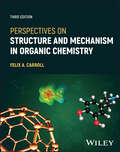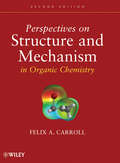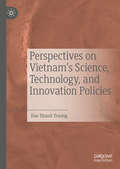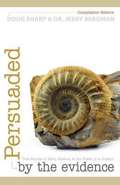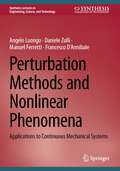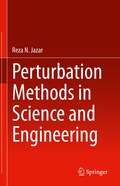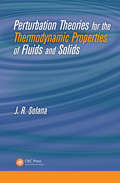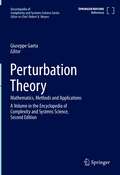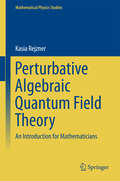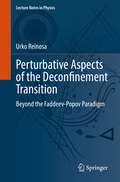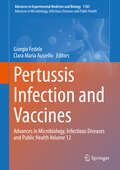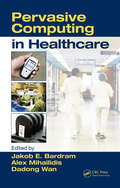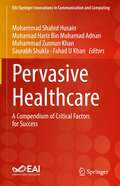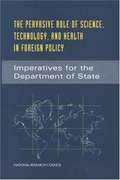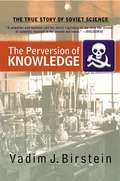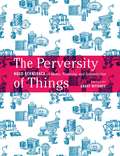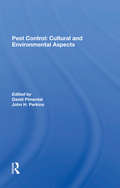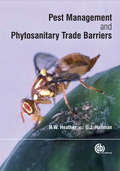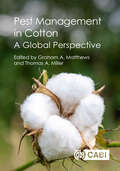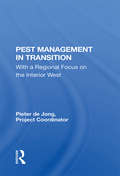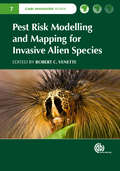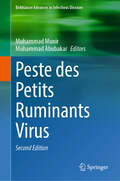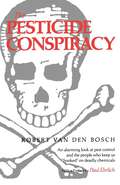- Table View
- List View
Perspectives on Structure and Mechanism in Organic Chemistry
by Felix A. CarrollPERSPECTIVES ON STRUCTURE AND MECHANISM IN ORGANIC CHEMISTRY “Beyond the basics” physical organic chemistry textbook, written for advanced undergraduates and beginning graduate students Based on the author’s first-hand classroom experience, Perspectives on Structure and Mechanism in Organic Chemistry uses complementary conceptual models to give new perspectives on the structures and reactions of organic compounds, with the overarching goal of helping students think beyond the simple models of introductory organic chemistry courses. Through this approach, the text better prepares readers to develop new ideas in the future. In the 3rd Edition, the author thoroughly updates the topics covered and reorders the contents to introduce computational chemistry earlier and to provide a more natural flow of topics, proceeding from substitution, to elimination, to addition. About 20% of the 438 problems have been either replaced or updated, with answers available in the companion solutions manual. To remind students of the human aspect of science, the text uses the names of investigators throughout the text and references material to original (or accessible secondary or tertiary) literature as a guide for students interested in further reading. Sample topics covered in Perspectives on Structure and Mechanism in Organic Chemistry include: Fundamental concepts of organic chemistry, covering atoms and molecules, heats of formation and reaction, bonding models, and double bonds Density functional theory, quantum theory of atoms in molecules, Marcus Theory, and molecular simulations Asymmetric induction in nucleophilic additions to carbonyl compounds and dynamic effects on reaction pathways Reactive intermediates, covering reaction coordinate diagrams, radicals, carbenes, carbocations, and carbanions Methods of studying organic reactions, including applications of kinetics in studying reaction mechanisms and Arrhenius theory and transition state theory A comprehensive yet accessible reference on the subject, Perspectives on Structure and Mechanism in Organic Chemistry is an excellent learning resource for students of organic chemistry, medicine, and biochemistry. The text is ideal as a primary text for courses entitled Advanced Organic Chemistry at the upper undergraduate and graduate levels.
Perspectives on Structure and Mechanism in Organic Chemistry
by Felix A. CarrollHelps to develop new perspectives and a deeper understanding of organic chemistryInstructors and students alike have praised Perspectives on Structure and Mechanism in Organic Chemistry because it motivates readers to think about organic chemistry in new and exciting ways. Based on the author's first hand classroom experience, the text uses complementary conceptual models to give new perspectives on the structures and reactions of organic compounds.The first five chapters of the text discuss the structure and bonding of stable molecules and reactive intermediates. These are followed by a chapter exploring the methods that organic chemists use to study reaction mechanisms. The remaining chapters examine different types of acid-base, substitution, addition, elimination, pericyclic, and photochemical reactions.This Second Edition has been thoroughly updated and revised to reflect the latest findings in physical organic chemistry. Moreover, this edition features:New references to the latest primary and review literatureMore study questions to help readers better understand and apply new concepts in organic chemistryCoverage of new topics, including density functional theory, quantum theory of atoms in molecules, Marcus theory, molecular simulations, effect of solvent on organic reactions, asymmetric induction in nucleophilic additions to carbonyl compounds, and dynamic effects on reaction pathwaysThe nearly 400 problems in the text do more than allow students to test their understanding of the concepts presented in each chapter. They also encourage readers to actively review and evaluate the chemical literature and to develop and defend their own ideas.With its emphasis on complementary models and independent problem-solving, this text is ideal for upper-level undergraduate and graduate courses in organic chemistry.
Perspectives on the Marine Animal Forests of the World
by Sergio Rossi Lorenzo BramantiMarine Animal Forests (MAFs) are spread all over the world. Composed by suspension feeding organisms (e.g. corals, gorgonians, sponges, bryozoans, bivalves, etc.), MAFs constitute a vast number of marine ecosystems such as coral reefs, cold water corals, sponge grounds, bivalve beds, etc. The surface covered by these systems is prominent (at the scale of the oceans of the planet), though poorly known. In a previous book (Marine Animal Forests, the ecology of benthic biodiversity hotspots), several aspects of the MAFs were described and discussed, building the basis for a holistic approach with the aim of putting these shallow and deep sea ecosystems under a common umbrella. The main target of the present book is to identify and address important topics which were not covered in the previous three volumes. Bryozoans or Polychaeta, for example, are treated in this volume, as well as hydrothermal vents ecosystems and submarine caves, the chemical ecology in MAFs or the nursery effect on these ecosystems. The vastity of the MAF concept opens new insights in the biology, physiology, biodiversity of the organisms structuring these highly biodiverse ecosystems and on the dangers threatening them (such as microplastics or the role of invasive species as an impact of their trophic ecology or distribution). In a fast changing world, in which the complexity of MAFs is at risk, we propose an in-depth analysis of many aspects that may be inspirational for future research lines in marine biology and ecology.
Perspectives on Vietnam’s Science, Technology, and Innovation Policies
by Dao Thanh TruongThis book provides an overview of the science, technology, and innovation (STI) policies in Vietnam in a globalized world. Science, technology and innovation policies play important roles in boosting research and development, promoting entrepreneurship and building national innovation systems, especially in developing countries. The author offers in-depth analyses and insights on the STI system of Vietnam and provides comparisons with the major STI development trends around the world. Each chapter of the book includes intensive studies and analyses of the STI system and policies in Vietnam, providing valuable arguments and essential tools for students, researchers, and policy makers in the field of science and technology management, political science, public policy and business studies. The author then addresses potential challenges and proposes policy recommendations to overcome them to improve the performance of the Vietnam's STI system in the context of globalized economies and international integration of science and technology.
Persuaded by the Evidence
by Dr Jerry Bergman Doug SharpTrue Stories of Faith, Science, & the Power of a Creator A unique and interesting collection of true stories from Christians - each sharing his personal journey to find the biblical truth of a six-day creation! From scientists in the midst of complex research to youth ministers, and more, see how each began at a different point and place in his life to question the supposed truth of evolution and how faith and actual evidence led to his embracing a creation-based, biblical world-view. In their testimonies, you will read about their search for answers, often unavailable through their school, their church, or scientific knowledge - and how the discoveries they made have shaped their faith and changed their lives. Seeking answers for yourself? Discover the powerful truths these individuals now share - and find yourself also persuaded by the evidence! Contributors include: Carl Kerby, Curt Sewell, Dr. Walter T. Brown, Dr. Raymond Damadian, Frank Sherwin, and more! Stories Focus on: Powerful testimonies of the concept of a creator Discovering creation truths within scientific careers Understanding the relevance of Genesis to your personal faith Finding answers to life's toughest questions through understanding Genesis Appreciating the powerful influence of creation believers and scholars Features a "Founding Fathers of Creationism" special section focused on Dr. Henry Morris, Dr. John Whitcomb, Dr. Andrew Snelling, and more. Special spotlight! Short biography of Dr. Mortimer Adler, chairman of the board of editors of Encyclopedia Britannica for many years
Perturbation Methods and Nonlinear Phenomena: Applications to Continuous Mechanical Systems (Synthesis Lectures on Engineering, Science, and Technology)
by Angelo Luongo Daniele Zulli Manuel Ferretti Francesco D’AnnibaleThis concise text introduces the reader to the use of perturbation methods, able to investigate nonlinear phenomena in continuous (not only discrete) mechanical systems. Distinct from the classic books on perturbation methods, the algorithms are directly illustrated for continuous systems, referring to a very simple case-study as well as to a metamodel, for which Statics, Buckling, Dynamics and Bifurcation behavior are quickly analyzed. Moreover, fundamental mechanical aspects are discussed in dealing with applications. Concepts herein are reinforced with worked examples at the end the book, relevant to several continuous systems.
Perturbation Methods in Science and Engineering
by Reza N. JazarPerturbation Methods in Science and Engineering provides the fundamental and advanced topics in perturbation methods in science and engineering, from an application viewpoint. This book bridges the gap between theory and applications, in new as well as classical problems. The engineers and graduate students who read this book will be able to apply their knowledge to a wide range of applications in different engineering disciplines. The book begins with a clear description on limits of mathematics in providing exact solutions and goes on to show how pioneers attempted to search for approximate solutions of unsolvable problems. Through examination of special applications and highlighting many different aspects of science, this text provides an excellent insight into perturbation methods without restricting itself to a particular method. This book is ideal for graduate students in engineering, mathematics, and physical sciences, as well as researchers in dynamic systems.
Perturbation Theories for the Thermodynamic Properties of Fluids and Solids
by J. R. SolanaThis book, Perturbation Theories for the Thermodynamic Properties of Fluids and Solids, provides a comprehensive review of current perturbation theories-as well as integral equation theories and density functional theories-for the equilibrium thermodynamic and structural properties of classical systems. Emphasizing practical applications, the text
Perturbation Theory: Mathematics, Methods and Applications (Encyclopedia of Complexity and Systems Science Series)
by Giuseppe GaetaThis volume in the Encyclopedia of Complexity and Systems Science, Second Edition, is devoted to the fundamentals of Perturbation Theory (PT) as well as key applications areas such as Classical and Quantum Mechanics, Celestial Mechanics, and Molecular Dynamics. Less traditional fields of application, such as Biological Evolution, are also discussed. Leading scientists in each area of the field provide a comprehensive picture of the landscape and the state of the art, with the specific goal of combining mathematical rigor, explicit computational methods, and relevance to concrete applications. New to this edition are chapters on Water Waves, Rogue Waves, Multiple Scales methods, legged locomotion, Condensed Matter among others, while all other contributions have been revised and updated. Coverage includes the theory of (Poincare’-Birkhoff) Normal Forms, aspects of PT in specific mathematical settings (Hamiltonian, KAM theory, Nekhoroshev theory, and symmetric systems), technical problems arising in PT with solutions, convergence of series expansions, diagrammatic methods, parametric resonance, systems with nilpotent real part, PT for non-smooth systems, and on PT for PDEs [write out this acronym partial differential equations]. Another group of papers is focused specifically on applications to Celestial Mechanics, Quantum Mechanics and the related semiclassical PT, Quantum Bifurcations, Molecular Dynamics, the so-called choreographies in the N-body problem, as well as Evolutionary Theory. Overall, this unique volume serves to demonstrate the wide utility of PT, while creating a foundation for innovations from a new generation of graduate students and professionals in Physics, Mathematics, Mechanics, Engineering and the Biological Sciences.
Perturbative Algebraic Quantum Field Theory
by Kasia RejznerPerturbative Algebraic Quantum Field Theory (pAQFT), the subject of this book, is a complete and mathematically rigorous treatment of perturbative quantum field theory (pQFT) that doesn't require the use of divergent quantities and works on a large class of Lorenzian manifolds. We discuss in detail the examples of scalar fields, gauge theories and the effective quantum gravity. pQFT models describe a wide range of physical phenomena and have remarkable agreement with experimental results. Despite this success, the theory suffers from many conceptual problems. pAQFT is a good candidate to solve many, if not all, of these conceptual problems. Chapters 1-3 provide some background in mathematics and physics. Chapter 4 concerns classical theory of the scalar field, which is subsequently quantized in chapters 5 and 6. Chapter 7 covers gauge theory and chapter 8 discusses effective quantum gravity. The book aims to be accessible to researchers and graduate students, who are interested in the mathematical foundations of pQFT.
Perturbative Aspects of the Deconfinement Transition: Beyond the Faddeev-Popov Paradigm (Lecture Notes in Physics #1006)
by Urko ReinosaThis book offers an original view of the color confinement/deconfinement transition that occurs in non-abelian gauge theories at high temperature and/or densities. It is grounded on the fact that the standard Faddeev-Popov gauge-fixing procedure in the Landau gauge is incomplete. The proper analysis of the low energy properties of non-abelian theories in this gauge requires, therefore, the extension of the gauge-fixing procedure, beyond the Faddeev-Popov recipe. The author reviews various applications of one such extension, based on the Curci-Ferrari model, with a special focus on the confinement/deconfinement transition, first in the case of pure Yang-Mills theory, and then, in a formal regime of Quantum Chromodynamics where all quarks are considered heavy. He shows that most qualitative aspects and also many quantitative features of the deconfinement transition can be accounted for within the model, with only one additional parameter. Moreover, these features emerge in a systematic and controlled perturbative expansion, as opposed to what would happen in a perturbative expansion within the Faddeev-Popov model. The book is also intended as a thorough and pedagogical introduction to background field gauge techniques at finite temperature and/or density. In particular, it offers a new and promising view on the way these techniques might be applied at finite temperature. The material aims at graduate students or researchers who wish to deepen their understanding of the confinement/deconfinement transition from an analytical perspective. Basic knowledge of gauge theories at finite temperature is required, although the text is designed in a self-contained manner, with most concepts and tools introduced when needed. At the end of each chapter, a series of exercises is proposed to master the subject.
Pertussis Infection and Vaccines: Advances in Microbiology, Infectious Diseases and Public Health Volume 12 (Advances in Experimental Medicine and Biology #1183)
by Giorgio Fedele Clara Maria AusielloThis book provides a comprehensive overview of pertussis - also known as whooping cough. The first part discusses the evolution the genus Bordetellae and the molecular epidemiology of B. pertussis, while the following chapters focus on the role of B. pertussis virulence factors in infection and disease and on the mechanisms of the immune response to infection and vaccination. The book also explores the prevention and control of the disease as well as its clinical management, with the finally section addressing vaccination, from improved immunization strategies to novel vaccines.Pertussis remains one of the most poorly controlled vaccine-preventable diseases around the globe. Universal vaccination has dramatically reduced its incidence but has failed to bring it completely under control. In recent decades, changes in pertussis epidemiology have been noted, likely related to the use of acellular pertussis vaccines, which in many countries have replaced older-generation, whole-cell pertussis vaccines. Several years after their introduction, it is becoming apparent that immunity conferred by acellular vaccines wanes more rapidly than expected. Unlike whole-cell vaccines, acellular vaccines, while protecting against the disease, do not seem to prevent colonization and transmission. Increasing incidence among adolescents and adults makes them a reservoir for transmission to unimmunized infants, who in turn are at risk of severe disease and death. This book is a valuable resource for researchers and clinicians in the field of medical microbiology, vaccine research and infectious diseases.
Pervasive Computing in Healthcare
by Jakob E. Bardram Alex Mihailidis Dadong WanWith skyrocketing costs due to the increase in the elderly population, a rapid increase in lifestyle-related and chronic diseases, demand for new medical treatments and technologies, and a shortage in the number of available clinicians, nurses, and other caregivers, the challenges facing the healthcare industry seem insurmountable. However, by tra
Pervasive Healthcare: A Compendium of Critical Factors for Success (EAI/Springer Innovations in Communication and Computing)
by Mohammad Shahid Husain Muhamad Hariz Bin Muhamad Adnan Mohammad Zunnun Khan Saurabh Shukla Fahad U. KhanThis book provides in depth knowledge about critical factors involved in the success of pervasive healthcare. The book first presents critical components and importance of pervasive healthcare. The authors then give insight into the pervasive healthcare information systems and key consideration related to remote patient monitoring and safety. The book provides in-depth discussion about the security issues and protocols for pervasive healthcare. This book explores concepts and techniques behind the successive pervasive healthcare systems by providing in-depth knowledge about patient empowerment, remote patient monitoring, network establishment and protocols for effective pervasive healthcare. The book also provides case studies in the field. It is an ideal resource for researchers, students and healthcare organizations to get insight about the state of the art in pervasive healthcare systems.Provides current research, developments, and applications in pervasive healthcare;Includes technologies such as machine learning, cryptography, fog computing, and big data in the advancement of e-healthcare;Pertinent for researchers, students, practitioners and healthcare decision makers.
The Pervasive Role of Science, Technology, and Health in Foreign Policy: Imperatives for the Department of State
by Committee on Science Technology Health Aspects of the Foreign Policy Agenda of the United StatesIssues involving science, technology, and health (STH) have moved to the forefront of the international diplomatic agenda. Other vital issues linked to technological developments pervade longer-range foreign policy concerns. Thus, STH considerations are often central to the Department of State’s bilateral and multilateral interactions with other governments. STH aspects play a large role in discussions of such critical topics as nuclear nonproliferation, use of outer space, population growth, adequate and safe food supply, climate change, infectious diseases, energy resources, and competitiveness of industrial technologies. In addressing these issues, expert STH knowledge is essential to the anticipation and resolution of problems and to the achievement of foreign policy goals. The Department, recognizing that it requires strengthened capabilities to address such an array of topics, asked for suggestions by the National Research Council as to how it could better deal with foreign policy issues with STH content.
The Perversion of Knowledge: The True Story of Soviet Science
by Vadim J. BirsteinDuring the Soviet years, Russian science was touted as one of the greatest successes of the regime. Russian science was considered to be equal, if not superior, to that of the wealthy western nations. The Perversion of Knowledge, a history of Soviet science that focuses on its control by the KGB and the Communist Party, reveals the dark side of this glittering achievement. Based on the author’s firsthand experience as a Soviet scientist, and drawing on extensive Russian language sources not easily available to the Western reader, the book includes shocking new information on biomedical experimentation on humans as well as an examination of the pernicious effects of Trofim Lysenko’s pseudo-biology. Also included are many poignant case histories of those who collaborated and those who managed to resist, focusing on the moral choices and consequences. The text is accompanied by the author’s own translations of key archival materials, making this work an essential resource for all those with a serious interest in Russian history.
The Perversity of Things: Hugo Gernsback on Media, Tinkering, and Scientifiction (Electronic Mediations #52)
by Hugo GernsbackIn 1905, a young Jewish immigrant from Luxembourg founded an electrical supply shop in New York. This inventor, writer, and publisher Hugo Gernsback would later become famous for launching the first science fiction magazine, Amazing Stories, in 1926. But while science fiction&’s annual Hugo Awards were named in his honor, there has been surprisingly little understanding of how the genre began among a community of tinkerers all drawn to Gernsback&’s vision of comprehending the future of media through making. In The Perversity of Things, Grant Wythoff makes available texts by Hugo Gernsback that were foundational both for science fiction and the emergence of media studies.Wythoff argues that Gernsback developed a means of describing and assessing the cultural impact of emerging media long before media studies became an academic discipline. From editorials and blueprints to media histories, critical essays, and short fiction, Wythoff has collected a wide range of Gernsback&’s writings that have been out of print since their magazine debut in the early 1900s. These articles cover such topics as television; the regulation of wireless/radio; war and technology; speculative futures; media-archaeological curiosities like the dynamophone and hypnobioscope; and more. All together, this collection shows how Gernsback&’s publications evolved from an electrical parts catalog to a full-fledged literary genre.The Perversity of Things aims to reverse the widespread misunderstanding of Gernsback within the history of science fiction criticism. Through painstaking research and extensive annotations and commentary, Wythoff reintroduces us to Gernsback and the origins of science fiction.
Pest Control: Cultural And Environmental Aspects
by David Pimentel John H. PerkinsThe field of pest control research, of increasing importance in a world short of food, has been plagued for many years by a variety of problems, among them (1) the instability (including pesticide resistance) of many control techniques, (2) the continuing need for improved pest management methods to increase world food supplies, and (3) the environmental and social hazards of currently used pesticides. What historical or other factors affect the ability of science to generate useful new technologies to alleviate these three major problems? Are there barriers to cooperation among the different pest control specialists? This book attempts to answer these questions, examining past events and projecting likely impacts on contemporary pest management systems. The authors--sociologists, economists, lawyers, ecologists, political scientists, and pest control scientists--examine the social, economic, political, and ethical factors that are important in shaping pest management systems, as well as developmental patterns that show the importance of these factors in shaping today's systems.
Pest Management and Phytosanitary Trade Barriers
by Guy J. Hallman Neil W. HeatherA significant amount of the world's economy is based upon the international trade of agricultural produce. For the producing countries, a growing concern is the potential economic and ecological damage that invasive species could cause. While threats can be decreased through the regulation of items potentially carrying invasive species, the effect of such restrictions on international trade also needs to be considered. A balance must therefore be met that permits the transfer of produce while filtering out unwanted pests. Drawing on the author's extensive experience, the social and financial implications of phytosanitary trade barriers are reviewed. This book offers valuable and comprehensive coverage of pest related barriers and strategies for their implementation.
Pest Management in Cotton: A Global Perspective
by Zeeshan AhmedThis book presents a global overview of the background to, and the current state of, crop protection and pest management in cotton crops. Cotton is one of the most economically important crops in the world and has been grown for centuries but maintaining high yields of good quality requires sophisticated approaches to pest management. The introduction and use of pesticides over the decades significantly increased cotton yields but lead to many adverse environmental impacts. Over time, new and alternative insecticides were developed but overuse has enabled pests to develop significant resistance. The development of genetically modified cotton varieties with toxins derived from Bacillus thuringiensis enabled much improved control of lepidopteran larvae, including bollworms, but as the toxins had no effect on sucking pests, farmers had no choice but to continue using insecticides. Also, some of the new cotton varieties developed in recent times have not adapted to different climatic conditions and the quality of cotton fibre declined as a result. This book shows the need for more research to select cotton varieties with high quality fibres suitable for different cotton growing areas and to develop integrated pest management strategies to minimise the use of pesticides. It also demonstrates the need for an inter-disciplinary approach bringing together plant breeders, entomologists, plant pathologists, agronomists and agricultural engineers to achieve high yields of high quality cotton. In the future, farmers will need to adopt new technology to determine when and how pesticides are used in conjunction with cultural and biological control strategies. · Emphasises the importance of research on growing cotton in a world experiencing climate change · Demonstrates how crucial crop protection is in achieving high yields of high quality cotton · Shows how new technology will bring major changes in how cotton is grown in the future
Pest Management In Transition: With A Regional Focus On The Interior West
by Pieter De JongThis volume examines current pest control strategies, introduces new alternatives for pest control in the interior West, and documents successful integrated pest management programs from across the nation. The contributors include leaders in alternative pest control research, representatives of regional and federal agencies, grower organizations, i
Pest Risk Modelling and Mapping for Invasive Alien Species
by Denys Denys David David Steven Steven Rieks Rieks Craig Craig Frank Frank Susan Susan Darren Darren Marla Marla Hazel Hazel Roger Roger Robert C Venette Manuel Manuel Christelle Christelle Richard Richard Catherine Catherine Patrick PatrickOver the past century, the number of species that have been transported to areas outside their native range has increased steadily. New pests and pathogens place biological pressure on valuable resident species, but strict bans may conflict with trading and travel needs. An overview of how the conflict can be managed using pest risk mapping and modelling, this book uses worked examples to explain modelling and help development of tool kits for assessment.
Pest Risk Modelling and Mapping for Invasive Alien Species (CABI Invasives Series)
by Manuel Manuel Hazel Hazel Catherine Catherine Roger Roger Darren Darren Susan Susan Christelle Christelle Patrick Patrick David David Craig Craig Richard Richard Marla Marla Rieks Rieks Frank Frank Denys Denys Steven StevenOver the past century, the number of species that have been transported to areas outside their native range has increased steadily. New pests and pathogens place biological pressure on valuable resident species, but strict bans may conflict with trading and travel needs. An overview of how the conflict can be managed using pest risk mapping and modelling, this book uses worked examples to explain modelling and help development of tool kits for assessment.
Peste des Petits Ruminants Virus (Birkhäuser Advances in Infectious Diseases)
by Muhammad Munir Muhammad AbubakarThis book subtly presents the Peste des Petits Ruminants Virus (PPRV), a morbillivirus closely related to rinderpest virus, that decimates sheep and goats along with those of other susceptible domestic ruminants and many wildlife species. Following its first introduction to the West Africa in 1940, PPRV was rapidly disseminated across sub-Saharan Africa, the Middle East and Southern Asia. Recent outbreaks of PPR in Morocco and European part of Turkey are posing continuous threats to many European countries. This book focuses on the key dynamics of this deadly disease, and incorporates considerable historical detail, infection biology, comparative molecular biology, and pathophysiology of the disease. The accurate disease diagnosis, management, and prevention of the disease are crucial for clinicians. Thus, three chapters emphasize the traditional prophylactic measures, clinical outcome of the disease and clinical disease assessments. The genomic organization and molecularbiology of PPRV is described comprehensively. Because of the current sensitivity about an emergence of PPRV and successful Global Rinderpest Eradication Programme, finally a chapter is dedicated to explore the possibilities to control and eradicate the PPRV from the globe, the way similar to rinderpest virus. Collectively, this book consists of high quality scientific and historical research contributed by the top experts in the field, from all around the globe. Moreover, editor’s vast experience with PPRV and collaborations with other researchers worldwide make this book unique. This book offers a valuable reference source for virologists, field veterinarians, infection and molecular biologists, immunologists, scientists in related fields and veterinary school libraries.
The Pesticide Conspiracy
by Robert Van Den BoschProfessor van den Bosch of the University of California was one of the developers of Integrated Pest Management—the use of biological controls, improved pest knowledge and observation, and judicious application of chemicals only when absolutely necessary. His research often suggested that less or no pesticides should be applied, which made him the target of both open and clandestine attack from industry and government figures. In protest, he wrote this passionate account of what Ecology called "the ultimate social disaster of: evolving pesticide-resistant insects, the destruction of their natural predators and parasites, emergent populations of new insect pests, downstream water pollution, atmospheric pollution, the 'accidental' killing of wildlife and people, and the bankruptcies of indigenous and small farmers."As a new Introduction to this edition recounts, some lessening of dangerous overreliance on massive pesticide applications has been achieved since van den Bosch published this book in 1978—partly as a result of its influence. But the structural problems he described remain. The book has thus become a classic, along with Rachel Carson's Silent Spring.
